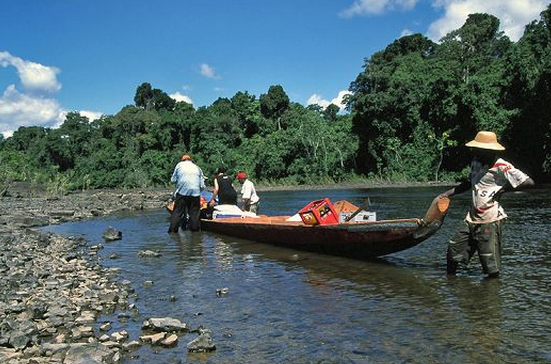Suriname's Second National Communication
Project Overview
The creation of a National Communication offers countries the opportunity to contribute with technically sound studies and information that can be used for designing mitigation and adaptation measures, and project proposals that can and will help increase their resilience to the impacts of climate change. Activities generally include: V&A assessments, Greenhouse Gas Inventory preparation, Mitigation Analysis or Education, and awareness raising activities. The ultimate goal is the integration of climate change considerations into relevant social, economic and environmental policies and actions.
The northern, lowland coastal area is particularly vulnerable to inundation and erosion of coastal zones and other negative impacts of climate change. Some of the proposed adaptation measures include: integrated coastal zone management, the efficient utilization of water resources, and the development of salt-tolerant crops. 90% of Suriname’s human activities such as agriculture and small industries are located here, along with a large share of the population. Coastal zones also include highly important ecosystems for the breeding and feeding of various species.
To view progress on Suriname's SNC click here.
Project Details
Suriname is located on the north-eastern coast of South America bordering French Guiana in the east, Brazil in the south, Guyana in the west, and the Atlantic Ocean in the north. The northern, lowland coastal area is particularly vulnerable to inundation and erosion of coastal zones and other negative impacts of climate change. Some of the proposed adaptation measures include: integrated coastal zone management, the efficient utilization of water resources, and the development of salt-tolerant crops.
Suriname’s climate is semi-humid, influenced by the behavior of the Inter Tropical Convergence Zone (ITCZ). The mean annual air temperature in Suriname is 27 degrees Celsius. Two rainy and two dry seasons occur annually. Suriname receives between 1500mm and 2500mm of rainfall each year. Suriname’s coastal zone is very fertile. 90 per cent of Suriname’s human activities such as agriculture and small industries are located here, along with a large share of the population. Coastal zones also include highly important ecosystems for the breeding and feeding of various species. The tropical rainforest in Suriname is one of the important natural resources, covering approximately 91 per cent or 15 million hectares of the total land area, of which about 2 million hectares or 13% has the status of Protected Areas.
The industrial base of Suriname is dominated by the mining and petroleum industries. To a lesser extent, the agricultural and tourism sectors also contribute to the country’s Gross Domestic Product (GDP). The vast majority of these industries are concentrated in coastal zones. Large-scale inundation associated with climate change could adversely affect these industries.
Reference: First National Communication 2005
Key Results and Outputs
- Sustainable development and the integration of climate change concerns into medium- and long-term planning
- Inventories of anthropogenic emissions by sources and removals by sinks of greenhouse gases
- Measures contributing to addressing climate change
- Research and systematic observation
- Climate change impacts, adaptation measures and response strategies
- Education, training and public awareness
Potential Adaptation Measures:
Agriculture and Food Security
- Enhance irrigation efficiency and/or expand irrigation
- Agricultural research and transfer of technology
- Develop new crops
Water Resources
- Increase water supply, e.g. by using groundwater, building reservoirs, improving or stabilizing watershed management, desalination
- Decrease water demands, e.g. by increasing efficiency, reducing water losses, water recycling, changing irrigation practices
- Improve or develop water management
Coastal Zones and Marine Ecosystems
- Develop Integrated Coastal Zone Management
- Protect, including building sea walls, and beach nourishment
Monitoring and Evaluation
In 1992, countries joined an international treaty, the United Nations Framework Convention on Climate Change, to cooperatively consider what they could do to limit average global temperature increases and the resulting climate change, and to cope with whatever impacts were, by then, inevitable.
Parties to the Convention must submit national reports on implementation of the Convention to the Conference of the Parties (COP). The required contents of national communications and the timetable for their submission are different for Annex I and non-Annex I Parties. This is in accordance with the principle of "common but differentiated responsibilities" enshrined in the Convention.
The core elements of the national communications for both Annex I and non-Annex I Parties are information on emissions and removals of greenhouse gases (GHGs) and details of the activities a Party has undertaken to implement the Convention. National communications usually contain information on national circumstances, vulnerability assessment, financial resources and transfer of technology, and education, training and public awareness.
Since 1994, governments have invested significant time and resources in the preparation, collection and validation of data on GHG emissions, and the COP has made determined efforts to improve the quality and consistency of the data, which are ensured by established guidelines for reporting. Non-Annex I Parties receive financial and technical assistance in preparing their national communications, facilitated by the UNFCCC secretariat.



